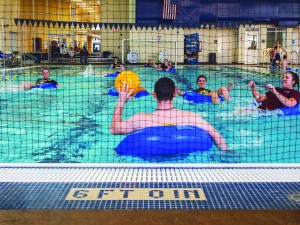
Campus recreation never ceases to expand, and Murray State proved it when inner tube water polo was officially introduced as an intramural sport.
Making its debut this year, inner tube water polo takes the traditional rules of water polo and mixes it with an extra set of regulations. Each team consists of five players and the primary
objective is to score goals and earn more points than the opponent.
“Inner tube water polo has been a very enjoyable experience,” said freshman Colton Robbins, a polo player for Kappa Alpha. “It wears you out, though. I have played water polo before, but it was nothing like inner tube water polo.”
Adding inner tubes to the sport eliminates the need to tread water, and it also creates a barrier between swimmers so there is less contact. Fouls are given to players who leave their inner tubes, and goals made while outside the tube do not count.
“For it being the first year, I think Murray State did an excellent job introducing it into our intramural program,” said junior Rob Noelker, another polo player for Kappa Alpha. “I hope there’s a tournament involved at the end of the season next year. If there isn’t, I would suggest that one be established.”
The final deadline for team registration was Feb. 12, and the last game took place Sunday. Steve Leitch, head of campus recreation, said getting the sport scheduled posed a challenge.
“Water polo was a little bit difficult for us,” he said. “We use the Wellness Center pool, and that’s mostly for lap swim. We wanted to be very careful about taking time away from the lap swimmers, and we didn’t want it to overlap our other intramural sports.”
Matches took place over a span of four weeks, every Sunday afternoon and evening. Leitch said he wanted the season to begin in February because the weather was too cold for outdoor recreation; that way it ended just in time for other outdoor sports to come in season.
Being in its first year, team registration was expected to be lower, Leitch said. However, the sport was popular, which forced the intramural program to expand the original time of the season.
In the men’s division, five fraternities, five residential colleges and one independent group registered teams. Three residential colleges and three sororities registered teams in the women’s division.
“We’re looking to expand more time for the season next year,” Leitch said. “We didn’t get all the fraternities, sororities and residential colleges this year, so we’re expecting more growth in the sport.”
While the season lasts the same amount of time as other intramural sports, inner tube water polo is different because much less time is invested. While other teams play or practice multiple times per week, water polo is given only one day. Leitch said this is mostly caused by scheduling issues and an incentive to keep the entry fee lower than the other sports.
“When you’re playing football or something else, the entry fee is $65 ,” he said. “We kept the entry fee low at $25 for water polo. It’s harder to schedule as many games and keep the entry fee low. When you consider that water polo is only getting around five games while major sports are getting seven or eight, it makes sense to keep the fees lower.”
Due to its inaugural success, campus recreation intends to keep inner tube water polo on as a minor sport for 2014.
Story by Carly Besser, Assistant Sports Editor.